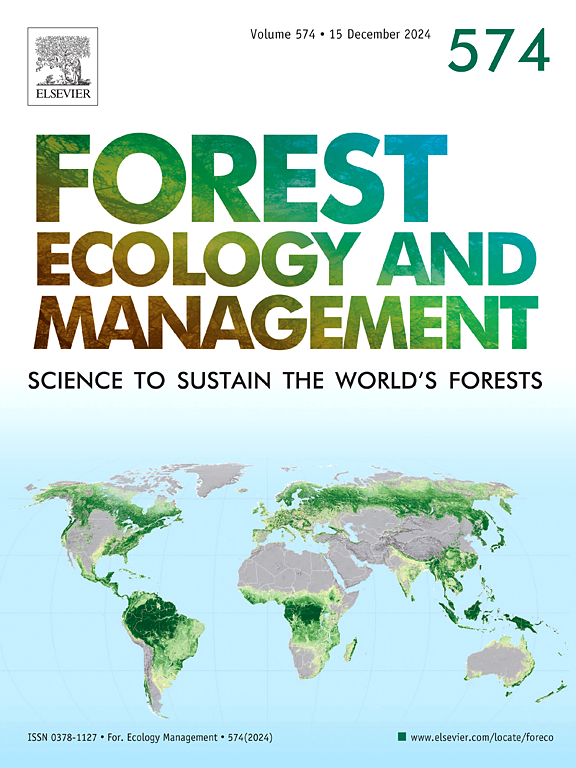Assessing the impacts of forest conversion and seasonal dynamics on soil nutrient heterogeneity associated with termite mounds
IF 3.7
2区 农林科学
Q1 FORESTRY
引用次数: 0
Abstract
Termite mounds function as nutrient hotspots, enhancing soil nutrient heterogeneity and microhabitat complexity. However, the extent of their influence across different land cover types and seasons has not been adequately explored. In this study, we investigated the impacts of a rubber plantation and a tropical natural forest on soil nutrient heterogeneity around termite mounds during both dry and wet seasons. We observed six termite mounds in the rubber plantation and eight in the natural forest. Soil samples were collected from termite nests and adjacent areas at increasing distances (0–5 m) in four cardinal directions. Results indicated that soil nutrient heterogeneity was significantly greater in the rubber plantation for exchangeable micronutrients (calcium, magnesium, manganese, and aluminum). In the natural forest, macronutrients (total carbon, total nitrogen, total phosphorus, and nitrite+nitrate) showed greater heterogeneity. Moreover, absolute concentrations of micronutrients were consistently higher in the rubber plantation than in the natural forest. This pattern likely reflects the accumulation of base cations from the subsoil layers for mound stability in the rubber plantation and the acidic conditions prevalent in the natural forest. Seasonal variations significantly influenced the concentrations of certain macronutrients (phosphorus, nitrite+nitrate, and ammonium) and micronutrients (aluminum and iron), but had limited effects on termite mound-associated heterogeneity across all soil nutrients. This highlights the consistent and unique influence of termite mounds on soil nutrient heterogeneity, regardless of seasonal variations. Understanding the soil heterogeneity around termite mounds underscores their critical role in nutrient distribution, biodiversity maintenance, and ecosystem resilience, with potential applications in improving ecological models and guiding conservation strategies.
评估森林转换和季节动态对白蚁丘相关土壤养分异质性的影响
白蚁丘作为养分热点,增强了土壤养分异质性和微生境复杂性。然而,它们对不同土地覆盖类型和季节的影响程度尚未得到充分探讨。本研究研究了橡胶林和热带天然林在干湿季节对白蚁丘周围土壤养分异质性的影响。在橡胶林和天然林中分别发现了6个和8个白蚁丘。在白蚁巢及其邻近区域沿4个基本方向逐次增加距离(0 ~ 5 m)采集土壤样本。结果表明:橡胶林土壤交换性微量元素(钙、镁、锰、铝)的养分异质性显著增强;在天然林中,总碳、总氮、总磷、亚硝酸盐+硝酸盐等常量营养元素表现出较大的异质性。此外,橡胶林中微量营养素的绝对浓度始终高于天然林。这种模式可能反映了橡胶林地基稳定所需的底土中碱性阳离子的积累以及天然林中普遍存在的酸性条件。季节变化显著影响某些常量元素(磷、亚硝酸盐+硝酸盐和铵)和微量元素(铝和铁)的浓度,但对所有土壤养分与白蚁丘相关的异质性影响有限。这突出了白蚁丘对土壤养分异质性的一致和独特的影响,无论季节变化如何。通过对白蚁丘周围土壤异质性的了解,揭示了白蚁丘在养分分布、生物多样性维持和生态系统恢复力方面的重要作用,并在改进生态模型和指导保护策略方面具有潜在的应用价值。
本文章由计算机程序翻译,如有差异,请以英文原文为准。
求助全文
约1分钟内获得全文
求助全文
来源期刊

Forest Ecology and Management
农林科学-林学
CiteScore
7.50
自引率
10.80%
发文量
665
审稿时长
39 days
期刊介绍:
Forest Ecology and Management publishes scientific articles linking forest ecology with forest management, focusing on the application of biological, ecological and social knowledge to the management and conservation of plantations and natural forests. The scope of the journal includes all forest ecosystems of the world.
A peer-review process ensures the quality and international interest of the manuscripts accepted for publication. The journal encourages communication between scientists in disparate fields who share a common interest in ecology and forest management, bridging the gap between research workers and forest managers.
We encourage submission of papers that will have the strongest interest and value to the Journal''s international readership. Some key features of papers with strong interest include:
1. Clear connections between the ecology and management of forests;
2. Novel ideas or approaches to important challenges in forest ecology and management;
3. Studies that address a population of interest beyond the scale of single research sites, Three key points in the design of forest experiments, Forest Ecology and Management 255 (2008) 2022-2023);
4. Review Articles on timely, important topics. Authors are welcome to contact one of the editors to discuss the suitability of a potential review manuscript.
The Journal encourages proposals for special issues examining important areas of forest ecology and management. Potential guest editors should contact any of the Editors to begin discussions about topics, potential papers, and other details.
 求助内容:
求助内容: 应助结果提醒方式:
应助结果提醒方式:


